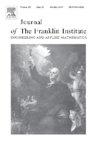An image encryption scheme based on new hyperchaos and encrypted kinoform
IF 3.7
3区 计算机科学
Q2 AUTOMATION & CONTROL SYSTEMS
Journal of The Franklin Institute-engineering and Applied Mathematics
Pub Date : 2025-06-06
DOI:10.1016/j.jfranklin.2025.107794
引用次数: 0
Abstract
This paper presents a new hyperchaotic system with excellent chaotic properties and a secure method for generating encrypted kinoforms. Based on these two techniques, a novel image encryption scheme is introduced. First, a two-dimensional (2D) hyperchaotic map, called 2D-SCM, is proposed, which combines the Sine map and the Cubic map. The chaotic properties of the system are evaluated through bifurcation diagrams, Lyapunov exponent spectra, phase diagrams, etc. The results indicate that the system exhibits excellent ergodicity and a broad range of hyperchaotic behavior. Second, to enhance the security and reduce the number of iterations, a method for fabricating encrypted kinoforms in the 2D non-separable linear canonical transform domain by use of the improved Fienup Gerchberg-Saxton algorithm is designed. Finally, an image encryption scheme is developed that combines the 2D-SCM hyperchaotic map with encrypted kinoform techniques. During the encryption process, the plaintext image is first shuffled using a 2D-SCM-based scrambling algorithm. The scrambled image is then used to generate the encrypted kinoform, which is subsequently decomposed into bit-planes and subjected to 2D-SCM-based cyclic shifts and XOR operations to obtain the final ciphertext. Experimental results demonstrate that the proposed image encryption scheme achieves a key space of 10¹⁸⁰, significantly exceeding those of traditional hyperchaos-based and holography-based methods. It also exhibits superior performance in local Shannon entropy tests compared to state-of-the-art algorithms, indicating enhanced randomness in the encrypted images. Furthermore, when the mean-squared error threshold is set to 10⁻³, the scheme offers greater encryption efficiency than the referenced methods, while maintaining reconstructed image quality above 30 dB, ensuring visual acceptability. These attributes contribute to the scheme's robust resistance against statistical, differential, and brute-force attacks.
一种基于新超混沌和加密相形的图像加密方案
本文提出了一种新的超混沌系统,该系统具有优良的混沌特性和一种安全的生成加密图像的方法。基于这两种技术,提出了一种新的图像加密方案。首先,结合正弦映射和立方映射,提出一种二维超混沌映射,称为2D- scm。通过分岔图、李雅普诺夫指数谱、相图等评价了系统的混沌特性。结果表明,该系统具有良好的遍历性和广泛的超混沌行为。其次,为了提高安全性和减少迭代次数,设计了一种利用改进的Fienup Gerchberg-Saxton算法在二维不可分线性正则变换域中生成加密kinoform的方法。最后,提出了一种将2D-SCM超混沌映射与加密同形技术相结合的图像加密方案。在加密过程中,明文图像首先使用基于2d - scm的置乱算法进行洗刷。然后用打乱后的图像生成加密的kinoform,随后将其分解为位平面,并进行基于2d - scm的循环移位和异或操作,以获得最终的密文。实验结果表明,所提出的图像加密方案实现了10¹⁸⁰的密钥空间,显著优于传统的基于超混沌和基于全息的方法。与最先进的算法相比,它在局部香农熵测试中也表现出优越的性能,表明加密图像的随机性增强。此外,当均方误差阈值设置为10⁻³时,该方案比参考方法具有更高的加密效率,同时将重建图像的质量保持在30 dB以上,保证了视觉上的可接受性。这些属性有助于该方案强大地抵抗统计攻击、差分攻击和暴力攻击。
本文章由计算机程序翻译,如有差异,请以英文原文为准。
求助全文
约1分钟内获得全文
求助全文
来源期刊
CiteScore
7.30
自引率
14.60%
发文量
586
审稿时长
6.9 months
期刊介绍:
The Journal of The Franklin Institute has an established reputation for publishing high-quality papers in the field of engineering and applied mathematics. Its current focus is on control systems, complex networks and dynamic systems, signal processing and communications and their applications. All submitted papers are peer-reviewed. The Journal will publish original research papers and research review papers of substance. Papers and special focus issues are judged upon possible lasting value, which has been and continues to be the strength of the Journal of The Franklin Institute.

 求助内容:
求助内容: 应助结果提醒方式:
应助结果提醒方式:


